Franklin County, Arkansas
Franklin County is a county in Arkansas. As of the 2020 census, the population was 17,097.[1] The county has two county seats, Charleston and Ozark.[2] The county was formed on December 19, 1837, and named for Benjamin Franklin,[3] American statesman. Franklin County is a damp county, with alcohol sales allowed except in Prairie & Alix townships, and limits on liquor sales in the city of Branch.[4]
Franklin County | |
|---|---|
 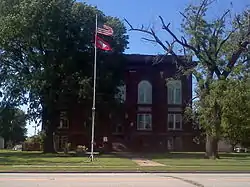  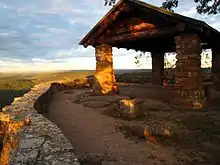 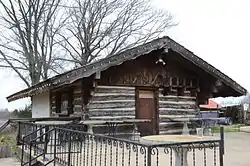 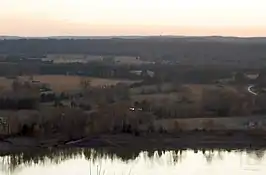 Clockwise from top: The Ozark Bridge over the Arkansas River, Franklin County Courthouse in Ozark, the Wiederkehr Wine Cellar near Altus, Sunset from Reed Mountain overlooking the Arkansas River Valley, Overlook at White Rock Mountain in the Ozark National Forest, Franklin County Courthouse in Charleston | |
 Flag  Seal | |
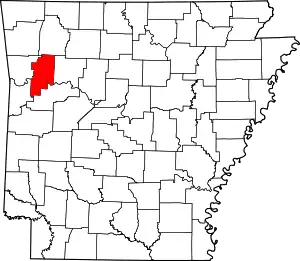 Location within the U.S. state of Arkansas | |
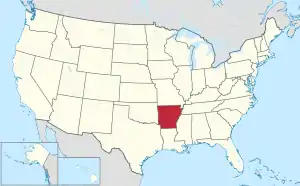 Arkansas's location within the U.S. | |
| Coordinates: 35°31′15″N 93°52′33″W | |
| Country | |
| State | |
| Founded | December 19, 1837 |
| Named for | Benjamin Franklin |
| Seat | Ozark (northern district); Charleston (southern district) |
| Largest city | Ozark |
| Area | |
| • Total | 620 sq mi (1,600 km2) |
| • Land | 609 sq mi (1,580 km2) |
| • Water | 11 sq mi (30 km2) 1.7% |
| Population (2020) | |
| • Total | 17,097 |
| • Density | 28/sq mi (11/km2) |
| Time zone | UTC−6 (Central) |
| • Summer (DST) | UTC−5 (CDT) |
| Congressional district | 4th |
History
Franklin County was carved out of Crawford County in December 1837. At that time, Franklin was significantly larger than it is at present, encompassing part of present-day Logan County which was formed in 1871.
Initially, the county had a single courthouse at Ozark. To promote economic growth in the county, federal land grants were made in 1853 to incentivize the construction and operation of the Little Rock and Fort Smith Railroad. From receivership in 1875 after a railroad debt crisis, it was reorganized as the Little Rock and Fort Smith Railway.[5] A number of towns were established in the 1890s on the north bank of the river along its right of way. Many farmers purchased land that had been owned by the railway. After complaints about how difficult it was to cross the river at times, a second courthouse was established at Charleston for citizens in the settlements south of the river, sometime in the 1890s, probably after 1892 since "Charleston" did not appear in an 1893 railroad map in all capital letters as "OZARK" did.[5] In 1906 the railway was acquired by the St. Louis, Iron Mountain and Southern Railway. In 1917 the line became a backbone of the MoPac, which merged into the Union Pacific Railroad in 1982.
The reality television show, The Simple Life, starring Nicole Richie and Paris Hilton was filmed in Altus in 2003.
Geography
According to the U.S. Census Bureau, the county has a total area of 620 square miles (1,600 km2), of which 609 square miles (1,580 km2) is land and 11 square miles (28 km2) (1.7%) is water.[6]
Major highways
Adjacent counties
- Madison County (north)
- Johnson County (east)
- Logan County (southeast)
- Sebastian County (southwest)
- Crawford County (west)
National protected area
- Ozark National Forest (part)
Demographics
| Census | Pop. | Note | %± |
|---|---|---|---|
| 1840 | 2,665 | — | |
| 1850 | 3,972 | 49.0% | |
| 1860 | 7,298 | 83.7% | |
| 1870 | 9,627 | 31.9% | |
| 1880 | 14,951 | 55.3% | |
| 1890 | 19,934 | 33.3% | |
| 1900 | 17,395 | −12.7% | |
| 1910 | 20,638 | 18.6% | |
| 1920 | 19,364 | −6.2% | |
| 1930 | 15,762 | −18.6% | |
| 1940 | 15,683 | −0.5% | |
| 1950 | 12,358 | −21.2% | |
| 1960 | 10,213 | −17.4% | |
| 1970 | 11,301 | 10.7% | |
| 1980 | 14,705 | 30.1% | |
| 1990 | 14,897 | 1.3% | |
| 2000 | 17,771 | 19.3% | |
| 2010 | 18,125 | 2.0% | |
| 2020 | 17,097 | −5.7% | |
| U.S. Decennial Census[7] 1790–1960[8] 1900–1990[9] 1990–2000[10] 2010[11] | |||

2020 census
| Race | Number | Percentage |
|---|---|---|
| White (non-Hispanic) | 15,201 | 88.91% |
| Black or African American (non-Hispanic) | 78 | 0.46% |
| Native American | 199 | 1.16% |
| Asian | 162 | 0.95% |
| Pacific Islander | 10 | 0.06% |
| Other/Mixed | 956 | 5.59% |
| Hispanic or Latino | 491 | 2.87% |
As of the 2020 United States census, there were 17,097 people, 6,723 households, and 4,537 families residing in the county.
2000 census
As of the 2000 census,[14] there were 17,771 people, 6,882 households, and 4,961 families residing in the county. The population density was 29 inhabitants per square mile (11/km2). There were 7,673 housing units at an average density of 13 per square mile (5.0/km2). The racial makeup of the county was 96.17% White, 0.62% Black or African American, 0.80% Native American, 0.26% Asian, 0.06% Pacific Islander, 0.74% from other races, and 1.35% from two or more races. 1.74% of the population were Hispanic or Latino of any race.
There were 6,882 households, out of which 32.40% had children under the age of 18 living with them, 59.20% were married couples living together, 8.80% had a female householder with no husband present, and 27.90% were non-families. 24.60% of all households were made up of individuals, and 12.40% had someone living alone who was 65 years of age or older. The average household size was 2.51 and the average family size was 2.99.
In the county, the population was spread out, with 25.80% under the age of 18, 8.50% from 18 to 24, 26.70% from 25 to 44, 23.20% from 45 to 64, and 15.80% who were 65 years of age or older. The median age was 38 years. For every 100 females, there were 98.00 males. For every 100 females age 18 and over, there were 95.80 males.
The median income for a household in the county was $30,848, and the median income for a family was $36,189. Males had a median income of $27,907 versus $18,822 for females. The per capita income for the county was $14,616. About 10.60% of families and 15.20% of the population were below the poverty line, including 16.20% of those under age 18 and 15.70% of those age 65 or over.
Government
Over the past few election cycles, Franklin County has trended heavily towards the GOP. The last Democrat (as of 2020) to carry this county was Arkansas native Bill Clinton in 1996.
| Year | Republican | Democratic | Third party | |||
|---|---|---|---|---|---|---|
| No. | % | No. | % | No. | % | |
| 2020 | 5,677 | 79.63% | 1,300 | 18.24% | 152 | 2.13% |
| 2016 | 5,039 | 74.43% | 1,376 | 20.32% | 355 | 5.24% |
| 2012 | 4,631 | 70.81% | 1,726 | 26.39% | 183 | 2.80% |
| 2008 | 4,411 | 68.12% | 1,869 | 28.86% | 195 | 3.01% |
| 2004 | 4,181 | 57.36% | 3,008 | 41.27% | 100 | 1.37% |
| 2000 | 3,277 | 53.37% | 2,674 | 43.55% | 189 | 3.08% |
| 1996 | 2,246 | 36.30% | 3,269 | 52.83% | 673 | 10.88% |
| 1992 | 2,495 | 37.04% | 3,217 | 47.76% | 1,024 | 15.20% |
| 1988 | 3,588 | 58.93% | 2,458 | 40.37% | 43 | 0.71% |
| 1984 | 4,382 | 64.04% | 2,399 | 35.06% | 62 | 0.91% |
| 1980 | 3,448 | 53.66% | 2,716 | 42.27% | 262 | 4.08% |
| 1976 | 1,973 | 34.76% | 3,703 | 65.24% | 0 | 0.00% |
| 1972 | 3,678 | 74.60% | 1,252 | 25.40% | 0 | 0.00% |
| 1968 | 1,333 | 29.02% | 1,149 | 25.02% | 2,111 | 45.96% |
| 1964 | 1,580 | 36.76% | 2,685 | 62.47% | 33 | 0.77% |
| 1960 | 1,631 | 43.48% | 2,025 | 53.99% | 95 | 2.53% |
| 1956 | 1,137 | 41.03% | 1,614 | 58.25% | 20 | 0.72% |
| 1952 | 1,215 | 40.74% | 1,762 | 59.09% | 5 | 0.17% |
| 1948 | 391 | 18.69% | 1,591 | 76.05% | 110 | 5.26% |
| 1944 | 457 | 27.75% | 1,188 | 72.13% | 2 | 0.12% |
| 1940 | 319 | 16.60% | 1,601 | 83.30% | 2 | 0.10% |
| 1936 | 345 | 15.35% | 1,890 | 84.11% | 12 | 0.53% |
| 1932 | 275 | 12.30% | 1,896 | 84.83% | 64 | 2.86% |
| 1928 | 774 | 36.53% | 1,329 | 62.72% | 16 | 0.76% |
| 1924 | 422 | 23.05% | 1,188 | 64.88% | 221 | 12.07% |
| 1920 | 769 | 32.15% | 1,502 | 62.79% | 121 | 5.06% |
| 1916 | 582 | 25.74% | 1,679 | 74.26% | 0 | 0.00% |
| 1912 | 258 | 14.75% | 1,113 | 63.64% | 378 | 21.61% |
| 1908 | 565 | 27.40% | 1,311 | 63.58% | 186 | 9.02% |
| 1904 | 593 | 34.94% | 968 | 57.04% | 136 | 8.01% |
| 1900 | 485 | 25.74% | 1,367 | 72.56% | 32 | 1.70% |
| 1896 | 424 | 18.99% | 1,746 | 78.19% | 63 | 2.82% |
Communities
Cities
- Altus
- Branch
- Charleston (county seat)
- Ozark (county seat)
- Wiederkehr Village
Town
Ghost towns
Townships
Townships in Arkansas are the divisions of a county. Each township includes unincorporated areas; some may have incorporated cities or towns within part of their boundaries. Arkansas townships have limited purposes in modern times. However, the United States census does list Arkansas population based on townships (sometimes referred to as "county subdivisions" or "minor civil divisions"). Townships are also of value for historical purposes in terms of genealogical research. Each town or city is within one or more townships in an Arkansas county based on census maps and publications. The townships of Franklin County are listed below; listed in parentheses are the cities, towns, and/or census-designated places that are fully or partially inside the township. [16][17][18]
- Alix (part of Wiederkehr Village)
- Barham
- Black Oak
- Boston
- Cobb
- Cravens
- Donald (most of Branch)
- Grover
- Hogan (Altus, Denning, part of Wiederkehr Village)
- Hurricane
- Ivy
- Limestone
- McIlroy
- Middle
- Mill Creek
- Miller
- Morgan
- Mountain
- Mulberry
- Prairie (Charleston, small part of Branch)
- Shores
- Six Mile
- Walker
- Wallace
- Watalula
- Weaver
- White Oak (Ozark, most of Wiederkehr Village)
- White Rock
- Wittich
See also
References
- "Census - Geography Profile: Franklin County, Arkansas". United States Census Bureau. Retrieved January 19, 2023.
- "Find a County". National Association of Counties. Archived from the original on May 31, 2011. Retrieved June 7, 2011.
- Gannett, Henry (1905). The Origin of Certain Place Names in the United States. Govt. Print. Off. pp. 131.
- "Wet/Dry Status of Arkansas Counties". University of Arkansas System Division of Agriculture. Retrieved April 12, 2023.
- Map of Franklin County, Arkansas; showing the land grant of the Little Rock & Fort Smith Railway. United States. General Land Office. Little Rock & Fort Smith R.R. Co. Published: Washington, 1893. Accessed 3 February 2022.
- "2010 Census Gazetteer Files". United States Census Bureau. August 22, 2012. Retrieved August 26, 2015.
- "U.S. Decennial Census". United States Census Bureau. Retrieved August 26, 2015.
- "Historical Census Browser". University of Virginia Library. Retrieved August 26, 2015.
- Forstall, Richard L., ed. (March 27, 1995). "Population of Counties by Decennial Census: 1900 to 1990". United States Census Bureau. Retrieved August 26, 2015.
- "Census 2000 PHC-T-4. Ranking Tables for Counties: 1990 and 2000" (PDF). United States Census Bureau. April 2, 2001. Archived (PDF) from the original on March 27, 2010. Retrieved August 26, 2015.
- "State & County QuickFacts". United States Census Bureau. Archived from the original on June 7, 2011. Retrieved May 20, 2014.
- Based on 2000 census data
- "Explore Census Data". data.census.gov. Retrieved January 1, 2022.
- "U.S. Census website". United States Census Bureau. Retrieved May 14, 2011.
- "Dave Leip's Atlas of U.S. Presidential Elections". Retrieved November 18, 2016.
- 2011 Boundary and Annexation Survey (BAS): Franklin County, AR (PDF) (Map). U. S. Census Bureau. Archived from the original (PDF) on October 19, 2012. Retrieved August 25, 2011.
- "Arkansas: 2010 Census Block Maps - County Subdivision". United States Census Bureau. Retrieved May 28, 2014.
- "Franklin County townships map, 1930". Arkansas Digital Archives. Retrieved February 3, 2021.
Further reading
- Shropshire, Lola. Franklin County, Arkansas: Images of America, Arcadia Publishing, 128 pages, Aug 2000 ISBN 0-7385-0882-9